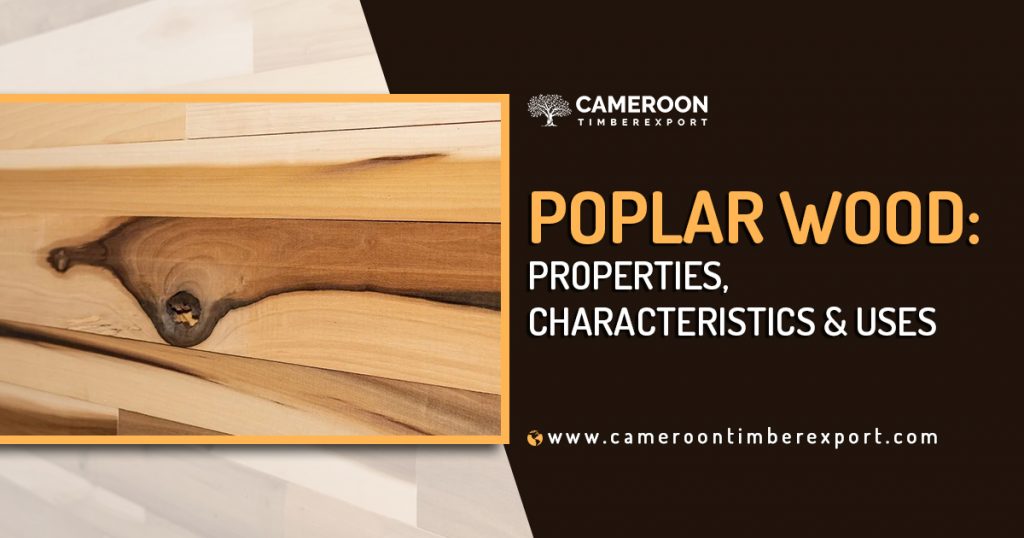Poplar, also called Black Poplar or Lombardy, is a hardwood used for plywood, furniture, lumber, construction, boxes and crates, and veneers, among other things. It’s a non-durable wood that is widely available at a low price. Veneers of poplar can, however, be expensive. Here’s everything else you need to know about Poplar wood properties and uses.
It is a light and cheap wood and is ideal for many uses. It is commonly used for making cheap furniture products, lumber, paper, crafts, boxes, plywood and other general utility items.
Poplar Wood Properties & Characteristics
Poplar has many names and species. Its scientific name is Populus nigra. It is found mainly in Europe, western Asia, and Northern Africa and is also planted as an ornamental plant in North America. The trees are about 65-100 ft (20-30 m) tall and have a 3-5 ft (1-1.5 m) trunk diameter. However, the white poplar and aspen poplar trees only grow to about 18m in height. The Janka rating of poplar is 460 lbf (2,020 N) and its dried weight is around 385 kg/m3, both of which indicate that the wood is neither heavy nor hard. On the contrary, it’s a lightweight wood.
Technical Poplar Wood Properties:
- Specific Gravity (Basic, 12% MC): .31, .39
- Modulus of Rupture: 9,230 lbf/in2 (63.7 MPa)
- Elastic Modulus: 1,045,000 lbf/in2 (7.21 GPa)
- Crushing Strength: 5,220 lbf/in2 (36.0 MPa)
- Shrinkage: Radial: 4.0%, Tangential: 9.3%, Volumetric: 12.3%, T/R Ratio: 2.3
In terms of appearance, it has a light brown-yellowish heartwood, while the sapwood is pale yellow or almost white. Poplar sometimes has a unique burl on its surface, which is quite popular and in demand and sold and used as Mappa or Mapa. It has a generally straight but sometimes interlocked or irregular grain and the texture is fine uniform medium.
In terms of strength and durability, it is non-durable and is prone to insect attack. It is also non-resistant to rot and moisture and is therefore not suitable for outdoor uses. Treatment must be used for wood if planning to use it outside or for flooring.
Despite being a hardwood, poplar is very soft, though it is strong for its weight The wood is easy to work with, cuts easily and is equally easy to glue and finish, though planing with regular cutters may lead to fuzzy surfaces (need sharp cutters for planing followed by fine-sanding to obtain smooth surfaces). Drying can cause the wood to warp or change shape. Poplar can be stained but the results are generally patchy because of the wood’s inconsistent absorption of stain, though it paints very well and looks premium after a good finish.
Because poplar is soft and light, it can get dents and scratches easily and is not therefore suitable for heavy-duty applications such as flooring.
Poplar has many species, of which the black Italian poplar is considered the best in terms of working abilities while white and grey species are among the worst. European aspen is also considered a good quality timber.
Poplar Availability, Price & Uses
It is easily available in many parts of the world and imported in other countries. In Europe, it is commonly sold and used as a utility lumber. In North America, it is mainly harvested as ornamental trees. Poplar is also grown in many parts of Africa. CameroonTimberExportSARL, which is one of the biggest suppliers of poplar wood in Northern Africa, supplies and exports top-quality poplar wood at wholesale rates all over the world. Contact us for the best price for its timber and hardwood logs.
While domestically grown poplar hardwood is generally low-priced, burl sections of poplar trees, which are generally sold and used as veneer sheets, can be quite expensive.
As a utility timber, poplar is used for everything from construction to furniture, plywood, boxes and crates, laminated lumber for construction, furniture carcasses, kitchen cabinets, carvings, doors, panelling, turnings, moulding, etc. Black poplar burl or Mappa burl is also used for decorative purposes and veneers, fine furniture, inlays, and drum shells.
Advantages & Disadvantages of Poplar Wood
Like any other wood or timber, it has its pros and cons, which you should know in order to determine whether or not it is the right wood for your project. Here you go.
Advantages of Poplar
1. Easy to work: Poplar is soft and therefore easy to work with both machine and hand tools. It cuts, dries and plans easily. The wood doesn’t usually have interlocked grain and cuts easily. The light weight of poplar makes it easy to transport and lift (for work on heights).
2. Inexpensive and widely available: One of the biggest advantages of poplar is that it comes cheap and is easily available.
Disadvantages of Poplar
1. Not hard or durable: Despite being a hardwood, poplar is rather soft with low density and hardness, so it dents and scratches easily and is also not suitable for heavy uses, construction, flooring, etc.
2. Requires high maintenance: Because it is soft, it requires constant care and maintenance. It is also prone to insect attacks and rot.
Other than that, poplar wood is not easy to stain (as we already explained above) and is not suitable for outdoor uses. It can, however, be vastly used for general applications, furniture, doors, cabinets, and everything else.
If you are looking to buy sustainable, best-quality poplar hardwood or timber at wholesale rates or need to know more about poplar species, feel free to contact us to talk to an expert.


